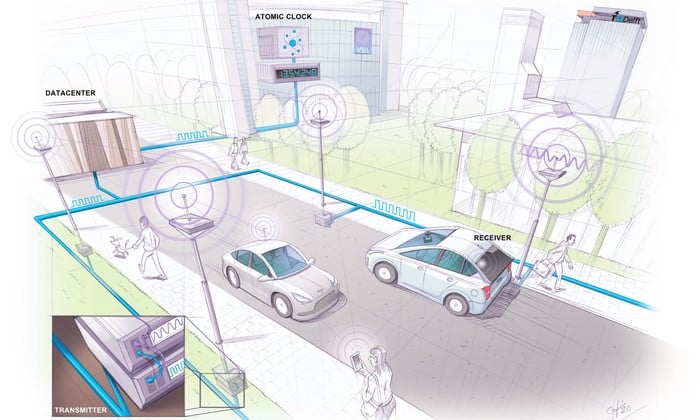
Researchers in the Netherlands have created a ground-based alternative to global satellite navigation systems (GNSSs) – claiming that it could offer a far greater positioning and timekeeping accuracy in cluttered urban environments. The team’s SuperGPS system uses an atomic-clock time signal that is distributed using existing optical and microwave telecommunications technologies. The team includes researchers from the Free University of Amsterdam, Delft University of Technology, and the company VSL.
A GNSS such as GPS comprises a “constellation” of satellites that broadcast signals to devices on the ground such as mobile phones. The signals tell the device where the satellites are and how long the signals took to reach the device. The device uses this information to calculate its location. High accuracy is achieved by having an atomic clock onboard each satellite.
However, for a GNSS to work the device on the ground must be able to receive signals from at least four satellites, which can be difficult when the user is indoors or surrounded by tall buildings. Furthermore, signal reflections from buildings can degrade the accuracy of a GNSS. This is not only a worry for navigation systems; GNSS timing signals are used to synchronize telecommunications networks and other systems.
Distributed signal
With these problems in mind, Christian Tiberius and colleagues created SuperGPS as a ground-based alternative to GNSS. Like a GNSS satellite, SuperGPS uses a time signal from an atomic clock. This signal is distributed to base stations using fibre optics. The base stations then broadcast the time signals to user devices using a high-bandwidth microwave signal. High bandwidth makes it possible for the system to weed-out signals that are reflected from buildings. Because microwave bandwidth is in short supply, this is done using several individual low-bandwidth signals to create a virtual high bandwidth that is about eight times wider than a GNSS signal. What is more, the signals used by SuperGPS are compatible with existing mobile phone technology.

X-ray ‘GPS’ unveiled by NASA
To test their design, the team installed six base stations over an area of 660 m2 on the Delft campus. They found that their system could achieve an accuracy on the order of 10 cm, which is better than that achieved by GNSSs in many urban environments.
The team say that SuperGPS could benefit a range of applications including automated vehicles, quantum communication and next-generation mobile communication systems. The system could also be used as a vital back-up to existing GNSSs and could form the basis of national timing networks.
The research is described in Nature.
